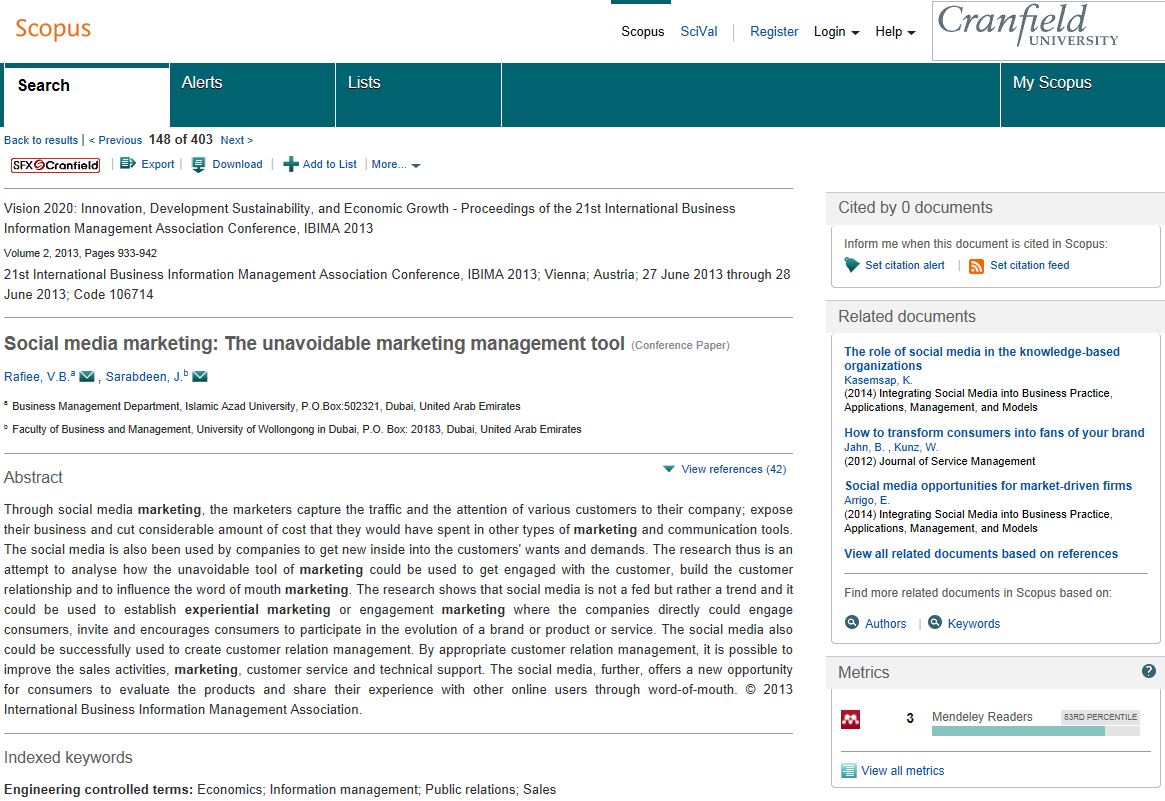How do I reference a conference paper… in the Cranfield Author-date style?
17/05/2016

As we enter thesis season, many of you may find that you are using conference papers in your research. Just like books and journal articles, these need to be referenced at the end of your work and, just to make life a bit more interesting, conference paper references have their own specific format, making them different to those for other articles or reports.
Let’s look first at the information you need to include to reference a conference paper in the Cranfield author-date style:
- Author(s) of paper (surname, initials)
- (Year of publication)
- ‘Title of paper’,
- Title of Conference: Subtitle.
- Location and date.
- Place of publication: Publisher,
- Paper number (if available),
- Volume (if known),
- Page range.
Here’s an example of a conference paper I found in my search:
The elements listed above will all come together to form the reference below:
Rafiee, V. B. and Sarabdeen, J. (2013) ‘Social media marketing: The unavoidable marketing management tool’, Vision 2020: Innovation, Development Sustainability, and Economic Growth – Proceedings of the 21st International Business Information Management Association Conference. Vienna, Austria, 27-28 June. Vienna: IBIMA, Vol. 2, pp. 933-942.
As you can see from the screenshot, I sourced this conference paper from Scopus. If your paper is available online, then you need to add in the URL and the date on which you accessed it, as you would do with any online source. These are added to the end of the reference, as shown here in blue.
Rafiee, V. B. and Sarabdeen, J. (2013) ‘Social media marketing: The unavoidable marketing management tool’, Vision 2020: Innovation, Development Sustainability, and Economic Growth – Proceedings of the 21st International Business Information Management Association Conference. Vienna, Austria, 27-28 June. Vienna: IBIMA, Vol. 2, pp. 933-942. Available at: http://www.scopus.com/ (Accessed: 25 January 2016).
In-text citations:
Where you make reference to this item in your text, follow the normal ‘name and date’ conventions and simply follow any mention with (Rafiee and Sarabdeen, 2013) or a variation thereon, remembering to add a page number where a direct quotation is involved.
As always, if you have any questions about referencing or citations, please contact the contact the Library service.
Feature image from Pixabay. Available at: https://cdn.pixabay.com/photo/2016/06/01/06/26/open-book-1428428_960_720.jpg
Categories & Tags:
Leave a comment on this post:
You might also like…
Library services over the Christmas period
Kings Norton Library and our School of Management Library will be open 24/7 throughout the holiday period as a study space. Library staff will work until 6pm on Friday 20 December and will resume their normal ...
How does Cranfield prepare me to be a Systems Engineer?
What is a systems engineer? ‘Systems engineering’ is not something that most people would think of when looking at how workplace cohesiveness is maintained, but in the last 30 years it has become an integral ...
Looking for case studies?
Case studies are used in many business schools to study real-life business and management scenarios. They can be particularly successful in generating discussion and debate around business themes. In the SOM Library, we are often ...
Using the Mendeley Cite Add-in with Word
You can use the Mendeley Cite Add-in with Word to create in-text references and bibliographies. Finding Mendeley Cite in Word To check that the Mendeley Cite add-in is installed in the version of Word that ...
Preparing for assignments and exams?
Sorry! We know it seems a bit mean to mention the exams in January rather than looking forward to the break before it! However, we know many of you will be thinking about your forthcoming ...
Researching… M&A
Mergers and acquisitions are constant headline-makers, from high-profile takeovers to game-changing mergers. But if you need to go beyond the headlines - whether for a coursework assignment, thesis, or just out of curiosity - where ...







